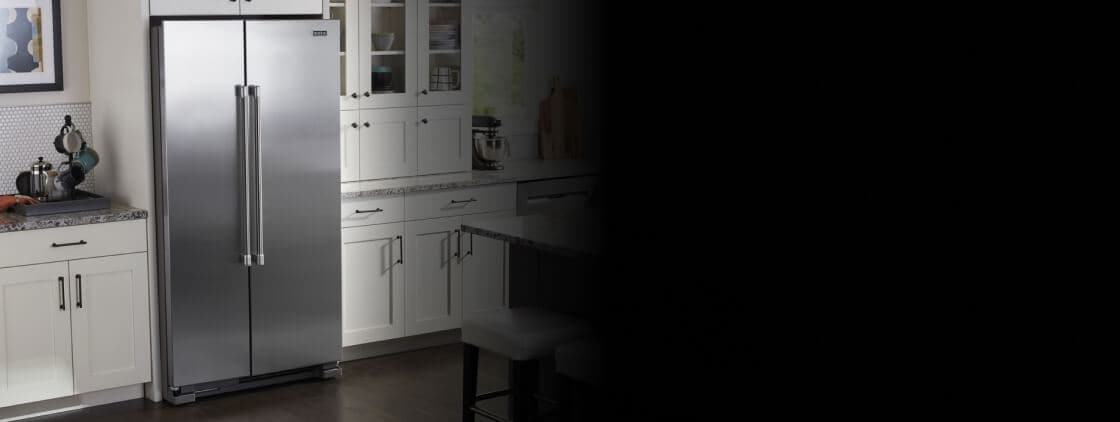
10 REASONS YOUR REFRIGERATOR IS NOT COOLING
A champion of your kitchen, you depend on your refrigerator to keep your food chilled and fresh. Realizing that your refrigerator is not cooling properly can be alarming, but it doesn’t necessarily mean that it needs replacement. Below, we'll cover some of the possible reasons your fridge is not cooling, and what you can do about it.

WHY IS MY REFRIGERATOR NOT COOLING?
It can be concerning when your refrigerator or freezer is not cooling properly, but the good news is that the cause may oftentimes be an easy fix. If your fridge seems to suddenly stop cooling, some common causes—listed from easiest to hardest to fix—can include:
A switched-off power source
An improperly set thermostat
Blocked vents
Dirty condenser coils
Dirty or faulty gaskets
Not enough space clearance
Improperly leveled installation
Broken or stuck condenser fan
Malfunctioning compressor
Faulty circuit board
Below you’ll find ways to troubleshoot these possible causes for your refrigerator not cooling like it is supposed to.

1. POWER SOURCE SWITCHED OFF OR UNPLUGGED
If your fridge isn’t cooling, double check that it is still plugged into the electrical outlet and that the switch powering your kitchen appliances hasn’t been switched off at the breaker box. If the light isn’t turning on in a fridge that’s not cooling, check the power source.

2. THERMOSTAT ISN’T SET PROPERLY
Your refrigerator temperature should ideally be kept between 32ºF-40ºF for optimal performance. If your fridge stops cooling, make sure that your thermostat is set within that range. Depending on the location of your refrigerator’s thermostat, it can be easy for little ones to change the settings by accident or for food items to bump into the switch.

3. BLOCKED VENT
Refrigerators require proper airflow in order to cool properly. If your refrigerator isn’t cooling, it may be because food items are blocking the vents of the fridge and/or freezer compartments. Overstuffing your fridge with food can cause items to block the vents and prevent the cool air from circulating properly. This can also cause food in the fridge to freeze.
Organize your fridge in a way that ensures proper airflow and move any items that may be blocking the vents. Less commonly, your freezer vent may be frosted over. In this case, you’ll want to remove the ice.

4. DIRTY CONDENSER COILS
Over time, your refrigerator may gather dust, dirt and other particles on the condenser coils. Generally located on the bottom or back of your fridge, these coils can become blocked by pet hair or dust. Blocked coils can make it more difficult for the heat from your refrigerator to be released, and may make the compressor work harder than it needs to.
To help prevent this problem, it’s recommended you clean your coils every two to three months if the environment around your refrigerator is particularly greasy or dusty, or if there is significant pet traffic in your home.

5. DIRTY OR FAULTY GASKETS
The soft, flexible seal that is found on the inside of your refrigerator door (gaskets) can become dirty or worn over time, which may prevent them from sealing your fridge properly. The gaskets help prevent cold air from escaping, keeping it within the refrigerator compartment instead. If you feel cold air escaping from your fridge, clean your gaskets and edges of your appliance with a sponge and warm, soapy water.
If after cleaning your gaskets, air continues to escape and your fridge is still not cooling, schedule a service call to have a technician help you with this issue.

6. NOT ENOUGH SPACE CLEARANCE
As refrigerators go through the cooling process, heat is released when the vapor refrigerant condenses into liquid form. Your fridge needs at least a half inch of clearance on the sides and one inch in the back in order for it to work at optimal performance levels.
Refer to your refrigerator’s installation instructions and check that you have the appropriate clearance space for your fridge to cool effectively.

7. IMPROPERLY LEVELED INSTALLATION
Your refrigerator may appear perfectly level, but even a slight tilt can affect the internal temperature. Uneven installation may prevent the doors from sealing properly, or cause other problems that lead to temperature fluctuations in the fridge. To troubleshoot the problem, grab a level and place it on top of the refrigerator, checking the leveling from both side to side and front to back. If the balance is a little off, don’t worry—just follow this simple leveling guide to help restore balance.

8. BROKEN OR STUCK CONDENSER FAN
Most refrigerators come with at least one fan, usually located behind the appliance. This fan keeps the condenser coils cool and in turn helps prevent the compressor from overheating. If you notice that your fan has stopped working, then you may want to consult a professional for repair.

9. MALFUNCTIONING COMPRESSOR
A refrigerator’s compressor kicks off the cooling cycle, drawing in refrigerant vapor (the cooling agent) to compress, then releasing it at a higher temperature and pressure. If your compressor is faulty, then the first step in the cooling process can be compromised and your refrigerator may have trouble keeping up.
It’s normal for a compressor to make whirring, hissing or dripping sounds, but there are some signs that can indicate a broken compressor. Your refrigerator compressor should run for a large portion of the day, but a compressor that’s running nonstop may be faulty. A circuit breaker that keeps tripping or a compressor making unusually loud noises may also point to a problem. Consult a professional if you think your refrigerator’s compressor isn’t performing at its best.
A compressor plays a primary role in keeping a refrigerator cool, so Maytag® refrigerator compressors are backed by a 10-year limited parts warranty1 to give you a cool you can count on, year after year.

10. FAULTY CIRCUIT BOARD
The circuit board is essentially the brains of the refrigerator, controlling everything from temperature regulation to powering individual parts. If after checking for different possible causes and troubleshooting your fridge it still isn’t cooling properly, then you may have a faulty circuit board. Replacing these can be expensive, so hiring a professional to diagnose and repair may be your safest bet.

FIND THE RIGHT FRIDGE FOR YOU
WHY IS MY FRIDGE NOT COOLING BUT MY FREEZER WORKS?
If your freezer is cooling but your fridge isn’t, there could be several reasons why, including:
Faulty or stuck evaporator fan
Damper control may be stuck or in the closed position
Faulty thermistor isn’t reading the temperature correctly
Temperature circuit board needs replacing
While most of these can have a fairly straightforward fix and can be addressed similarly to your fridge not cooling, note that if you check these components and they’re all working properly, your circuit board may need to be replaced, and should be done so by a professional.
HOW DO YOU RESET A REFRIGERATOR THAT IS NOT COOLING?
Resetting your refrigerator is simple and can help resolve functionality issues to get the temperature back on track. First, unplug or shut off the power to your fridge on your home’s circuit breaker. Leave it off for five to 10 minutes, then restore power and adjust the temperature settings to where you want them (aim for 32ºF-40ºF). It can take up to 24 hours for the refrigerator’s temperature to stabilize.
Unplugging your fridge may also be recommended if there is heavy frost buildup that is blocking the vent from letting cold air move its way down into the fridge compartment. Keep in mind, however, that you’ll need to unplug your fridge for at least 24 hours to ensure that all the ice melts off, so you’ll have to find a place to store your food during that time.

Maytag® refrigerators
Built strong to hold in the cold
Maytag® refrigerators are designed to help keep your perishables in their ideal climate
EXPLORE MAYTAG® REFRIGERATORS
If, after everything you realize that it’s time for a new fridge after all, Maytag brand offers a selection that is dependable and hardworking, so you can maintain a cool space for fresh food. Select models include the PowerCold® feature that filters in cold air from the freezer to drop the refrigerator’s temperature quickly, helping you cool the compartment after loading groceries or leaving the door open. Or, take advantage of the Temperature-Controlled Wide-N-Fresh™ Deli Drawer on select models that lets you set the ideal temperature for large party platters or deli trays.

MAYTAG® PERFORMANCE LINEUP
POWER PACKAGES THAT GET THE JOB DONE
Explore Maytag® kitchen appliances designed to power through mealtime and cleanup and look good while doing it
Was this article helpful? Pass it on
EXPLORE MORE FROM MAYTAG BRAND
1. See product warranty for details.


